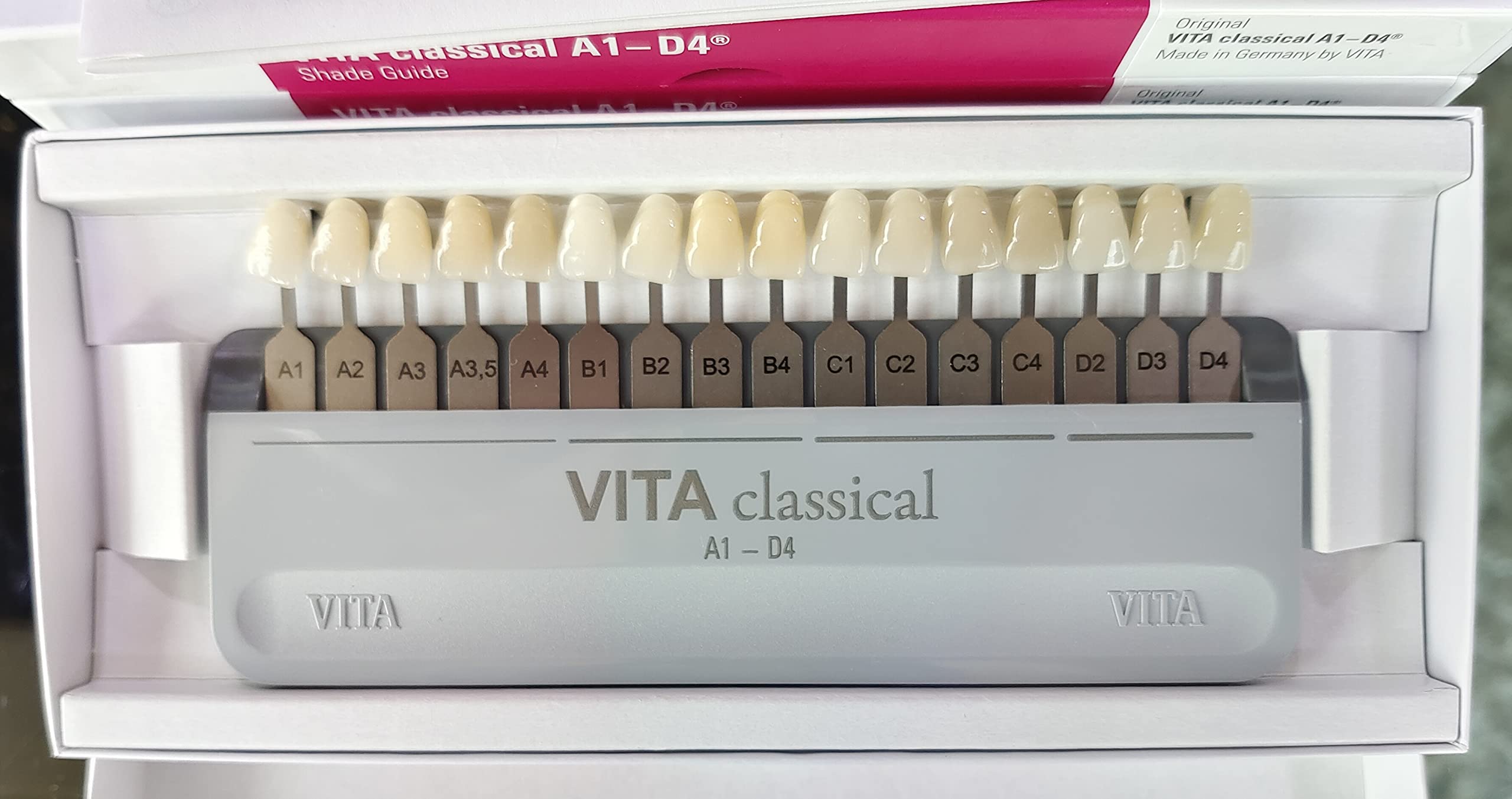Contents
- Why Choosing The Right Tooth Shade Is Important
- Understanding The Dental Shade Guide
- Factors To Consider When Selecting Tooth Shade
- Steps In The Tooth Shade Selection Process
- Common Challenges In Tooth Shade Selection
- Tips And Techniques For Effective Tooth Shade Selection
- Communicating Dental Shade Selection With Patients
- Shades And Trends In Cosmetic Dentistry
- Case Studies And Success Stories
- Frequently Asked Questions On Dental Shade Guide: Navigating Tooth Shade Selection
- Conclusion
Navigating tooth shade selection is simplified using a dental shade guide, which helps in accurately determining the shade of a patient’s teeth. In dental practices, the shade guide is an essential tool that enables dentists to match and select the most appropriate shade for restorative treatments.
The shade guide consists of a range of tooth shades, which are categorized based on color and brightness. By using the shade guide, dentists can ensure a more precise shade selection, resulting in better aesthetic outcomes and patient satisfaction. The guide also helps in communication between the dentist, dental technician, and patient, ensuring that the desired tooth shade is achieved.

Credit: www.speareducation.com
Why Choosing The Right Tooth Shade Is Important
Choosing the right tooth shade is crucial for achieving a stunning smile. The impact of tooth shade on overall smile aesthetics cannot be underestimated. It goes beyond just the physical appearance and has psychological and emotional effects as well. Tooth shade plays a significant role in cosmetic dentistry, as it helps in creating the desired look for patients.
Your smile is a reflection of your personality and confidence, and the tooth shade can greatly enhance or diminish those qualities. Therefore, it is important to carefully consider the tooth shade selection process, ensuring that it complements your skin tone, facial features, and overall smile goals.
With the right tooth shade, you can achieve a smile that not only looks natural but also boosts your self-esteem, making you feel more confident and happy.
Understanding The Dental Shade Guide
The dental shade guide is a valuable tool for selecting the right tooth shade. A dental shade guide includes several components that help in the shade selection process. There are different shade systems available, each with its own set of shade numbers and letters.
Understanding how to interpret these numbers and letters is crucial for achieving the desired outcome. By referring to the shade guide, dentists can accurately match the color of a patient’s natural teeth or select the appropriate shade for restorations or cosmetic procedures.
The shade guide provides a standardized system to ensure consistency and predictability in dental treatments. Dentists can compare the shade of the patient’s tooth to the shades provided in the guide, making it easier to determine the most suitable shade.
Factors To Consider When Selecting Tooth Shade
Factors to consider when selecting tooth shade include natural tooth color variations, skin tone and complexion, age and gender, and environment and lighting conditions. These factors play a significant role in achieving a harmonious and natural-looking smile. Natural tooth color variations can range from yellowish to grayish tones, and understanding the patient’s baseline shade is crucial for a seamless match.
Skin tone and complexion should also be taken into account, as certain shades may complement or clash with different skin tones. Age and gender can influence the preferred shade, with younger individuals often opting for brighter, lighter shades. Lastly, environmental factors, such as lighting conditions, should be considered, as different lighting can affect how the tooth shade appears.
By carefully analyzing these factors, dental professionals can navigate the dental shade guide to ensure optimal tooth shade selection and patient satisfaction.
Steps In The Tooth Shade Selection Process
The tooth shade selection process involves several steps. A comprehensive patient assessment is essential to understand their needs. Identifying patient preferences and expectations plays a crucial role in achieving satisfaction. Effective communication and collaboration with the dental lab are necessary for successful shade matching.
The trial and adjustment process allows for fine-tuning the selected shade. During this process, the dentist and the patient can work together to achieve the desired outcome. These steps ensure a precise and accurate tooth shade selection, enhancing the overall appearance and satisfaction of the patient.
The dental shade guide serves as a valuable tool in navigating this process, providing options to match natural teeth seamlessly. By following these steps, dentists can deliver customized and aesthetically pleasing results to their patients.
Common Challenges In Tooth Shade Selection
Tooth shade selection can be challenging due to the need for accurate replication of natural tooth colors. Discolored or compromised teeth can make the process even more complex. Dentists are faced with managing patient dissatisfaction with the final shade, as individuals may have varying expectations.
It is crucial to carefully navigate these challenges to achieve optimal results. The dental shade guide is a valuable tool in this process, allowing dentists to match the shade of restorations to the patient’s natural teeth. By ensuring a close match, dentists can help create a seamless and natural-looking smile.
Effective communication with patients and managing their expectations are also key to successful tooth shade selection. With thorough understanding and attention to detail, dentists can overcome the challenges associated with tooth shade selection to deliver exceptional results.
Tips And Techniques For Effective Tooth Shade Selection
Navigating tooth shade selection requires proper lighting and shade matching conditions. Digital shade analysis tools play a crucial role in achieving accurate results. To effectively utilize shade guides and shade tabs, understanding their variations is essential. Incorporating patient feedback and involvement ensures satisfaction with the final shade selection.
By considering patient preferences and expectations, a personalized approach can be taken. Throughout the selection process, maintaining open communication and collaboration with the patient creates a positive experience. Providing guidance on oral hygiene and care after dental procedures can further enhance patient satisfaction.
Achieving the desired tooth shade not only enhances the appearance of a smile but also boosts confidence and overall oral health.
Communicating Dental Shade Selection With Patients
Explaining the tooth shade selection process to patients is essential for effective communication. Patients’ expectations and concerns should be managed to ensure their satisfaction. Using visual aids and demonstrations can greatly enhance their understanding of the process. This allows patients to have a clear picture of the shade selection options available to them.
By avoiding jargon and using simple language, patients can easily grasp the concepts involved. Our goal is to make the process as transparent as possible, empowering patients to participate actively in their own dental care. Through open and honest communication, we can build trust and strengthen the dentist-patient relationship.
Together, we can navigate the dental shade selection process and achieve the best results for every individual.
Shades And Trends In Cosmetic Dentistry
Shades and trends in cosmetic dentistry vary according to popular tooth shades for different procedures. Current trends in tooth shade preference focus on balancing aesthetic goals with a natural look and durability. Dentists must navigate the dental shade guide to select the appropriate shade for each individual patient.
This ensures that the dental restoration seamlessly blends with the rest of their teeth, creating a harmonious smile. Whether it’s for veneers, crowns, or dental implants, the right tooth shade can make a significant difference in the overall appearance of the patient’s smile.
With advancements in dental technology, dentists now have a wide range of shades to choose from, allowing them to create beautiful and natural-looking smiles that meet their patients’ expectations. It’s important to keep up with the latest shade trends in order to provide the best possible outcomes for cosmetic dentistry procedures.
Case Studies And Success Stories
Successful tooth shade selection can have a significant impact on patients’ confidence and satisfaction. Real-life case studies provide valuable examples of this success. By analyzing these cases, valuable lessons can be learned, particularly from challenging situations. The ability to navigate the dental shade guide is essential in achieving optimal results.
These stories demonstrate the positive outcomes that can be achieved through careful selection and matching of tooth shades. Patients’ smiles are transformed, boosting their self-esteem and overall satisfaction with their dental experience. As dental professionals, we are constantly learning and adapting, using these case studies to improve our techniques and provide the best possible care for our patients.
Understanding the nuances of tooth shade selection is a crucial aspect of achieving successful outcomes in dentistry.
Frequently Asked Questions On Dental Shade Guide: Navigating Tooth Shade Selection
What Is A Dental Shade Guide?
A dental shade guide is a tool used by dentists to help select the most appropriate shade for dental restorations, such as crowns or veneers. It contains a range of tooth shades that dentists use to match the color of a patient’s natural teeth.
How Does Tooth Shade Selection Work?
Tooth shade selection involves comparing the patient’s natural teeth color to the shades in the dental shade guide. Dentists consider factors such as the patient’s age, skin tone, and tooth color variations to choose a shade that blends seamlessly with the patient’s smile.
This ensures a natural-looking and harmonious dental restoration.
Why Is Tooth Shade Selection Important?
Tooth shade selection is important because it plays a crucial role in achieving aesthetically pleasing dental restorations. A proper match between the restoration and the patient’s natural teeth color ensures that the restoration blends seamlessly, enhancing the overall appearance of the smile.
Can Tooth Shade Change Over Time?
Yes, tooth shade can change over time due to various factors. Aging, lifestyle habits (such as smoking or consuming staining foods and drinks), and certain medications can cause teeth to darken or become discolored. Regular dental check-ups and professional teeth whitening treatments can help maintain or improve the tooth shade.
What Are The Benefits Of Using A Dental Shade Guide?
Using a dental shade guide provides several benefits. It helps dentists achieve accurate and consistent tooth shade matching, resulting in natural-looking restorations. Patients benefit from improved aesthetic outcomes, as their restorations blend seamlessly with their natural teeth. Additionally, it allows for better communication between the dentist and dental laboratory, ensuring the desired outcome is achieved.
Conclusion
Navigating tooth shade selection can be a daunting task, but with the help of a dental shade guide, it becomes much easier. This comprehensive tool allows dentists to accurately match a patient’s desired tooth shade, ensuring a natural and confident smile.
By understanding the different shade categories and using the guide as a reference, dental professionals can guide their patients through the selection process with expertise and precision. It’s important to consider the patient’s expectations, the underlying tooth structure, and the overall aesthetic goals when making shade recommendations.
Additionally, effective communication between the dentist and patient is crucial to ensure the best possible outcome. With the right knowledge and tools, dental shade selection becomes a seamless process, leading to satisfied patients and beautiful smiles. So, next time you’re faced with the task of choosing a tooth shade, remember the valuable insights provided by the dental shade guide to achieve optimal aesthetic results.











